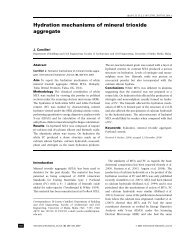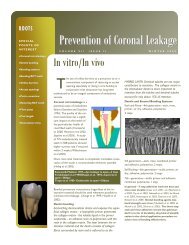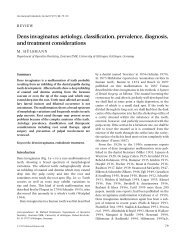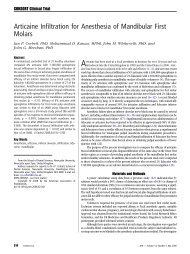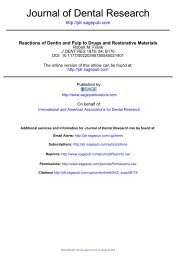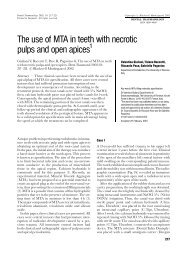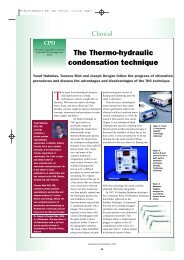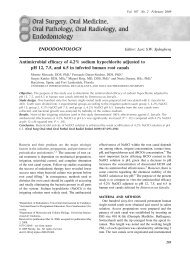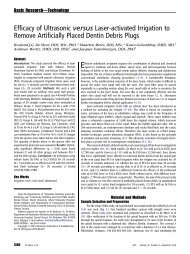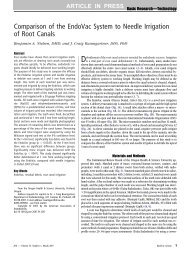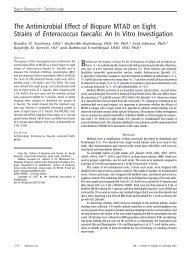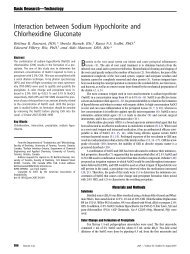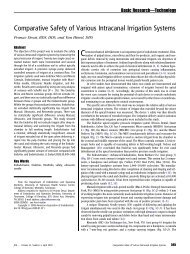Irrigation in Endodontics - The Endoexperience
Irrigation in Endodontics - The Endoexperience
Irrigation in Endodontics - The Endoexperience
You also want an ePaper? Increase the reach of your titles
YUMPU automatically turns print PDFs into web optimized ePapers that Google loves.
<strong>Irrigation</strong> <strong>in</strong> <strong>Endodontics</strong> 299<br />
than NaOCl/MTAD. 54,55 Comparative studies on MATD and Tetraclean have <strong>in</strong>dicated<br />
better antibacterial effects by the latter. 56 Although a mixture conta<strong>in</strong><strong>in</strong>g an antibiotic<br />
may have good short-term and long-term effects, concerns have been expressed<br />
regard<strong>in</strong>g the use of tetracycl<strong>in</strong>e (doxycycl<strong>in</strong>e) because of possible resistance to the<br />
antibiotic and sta<strong>in</strong><strong>in</strong>g of the tooth hard tissue, which has been demonstrated by exposure<br />
to light <strong>in</strong> an <strong>in</strong> vitro expreriment. 57 However, no report of <strong>in</strong> vivo sta<strong>in</strong><strong>in</strong>g has been<br />
published.<br />
CHALLENGES OF IRRIGATION<br />
Smear Layer<br />
Removal of the smear layer is straightforward and predictable when the correct<br />
irrigants are used. Rely<strong>in</strong>g on EDTA alone or other irrigants with activity aga<strong>in</strong>st the<br />
<strong>in</strong>organic matter only, however, results <strong>in</strong> <strong>in</strong>complete removal of the layer. <strong>The</strong>refore,<br />
use of hypochlorite dur<strong>in</strong>g <strong>in</strong>strumentation cannot be omitted (Fig. 8). <strong>The</strong> smear layer<br />
is created only on areas touched by the <strong>in</strong>struments. Delivery of irrigants to these<br />
areas is usually unproblematic, with the possible exception of the most apical canal,<br />
depend<strong>in</strong>g on canal morphology and the techniques/equipment used for irrigation.<br />
However, careless irrigation, with needles <strong>in</strong>troduced only to the coronal and middle<br />
parts of the root canal, is likely to result <strong>in</strong> <strong>in</strong>complete removal of the smear layer <strong>in</strong><br />
the apical root canal.<br />
Dent<strong>in</strong> Erosion<br />
One of the goals of endodontic treatment is to protect the tooth structure so that the<br />
physical procedures and chemical treatments do not cause weaken<strong>in</strong>g of the dent<strong>in</strong>/<br />
root. Erosion of dent<strong>in</strong> has not been studied much; however, there is a general<br />
consensus that dent<strong>in</strong> erosion may be harmful and should be avoided. A few studies<br />
have shown that long-term exposure to high concentrations of hypochlorite can lead<br />
to considerable reduction <strong>in</strong> the flexural strength and elastic modus of dent<strong>in</strong>. 19 <strong>The</strong>se<br />
studies have been performed <strong>in</strong> vitro us<strong>in</strong>g dent<strong>in</strong> blocks, which may allow artificially<br />
deep penetration of hypoclorite <strong>in</strong>to dent<strong>in</strong>. However, even short-term irrigation with<br />
hypochlorite after EDTA or CA at the end of chemomechanical preparation causes<br />
strong erosion of the canal-wall surface dent<strong>in</strong> (Fig. 9). 20 Although it is not known<br />
for sure whether surface erosion is a negative issue or if, for example, it could improve<br />
dent<strong>in</strong> bond<strong>in</strong>g for posts, it is the authors’ op<strong>in</strong>ion that hypochlorite irrigation after<br />
Fig. 8. Instrumented canal wall after removal of the smear layer by NaOCl and EDTA.



